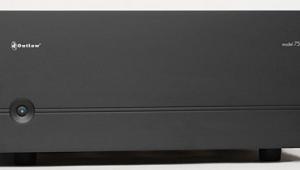Review: Job 225 stereo amplifier

"You test … amplifiers?" the lovely brunette MBA said to me from across the couch in the lobby of a hipster L.A. hotel. Sadly, my reply - "There are people who care about this stuff!" - didn't convince her of the value of my work. On some level, though, I'm in sympathy with her sentiment. While I do, on occasion, test amplifiers, I'm really a speaker and headphone reviewer.
With those products, I understand how the design decisions of engineers affect the sound. But while I understand quite well how amplifiers work, the sonic differences among amplifiers are relatively subtle, and plausible explanations for these differences are rare.
So why am I reviewing an amplifier? Because I couldn't resist a good backstory.
A couple of months ago, I was discussing the state of the audio industry with Michel Reverchon, CEO of Goldmund, a super-high-end audio company based in Geneva, Switzerland. Goldmund's products are sold exclusively through a small corps of dealers who are trained in installing the company's ultra-advanced, cost-no-object systems. When I asked Reverchon if he thought his company would ever distribute products through the Internet, he shocked me by saying, "We already do, on Amazon."
The product he was talking about isn't a Goldmund product per se, but it was designed by Goldmund engineers and manufactured in the company's Geneva factory. It's the Job 225, a stereo amp rated at 125 watts per channel into 8 ohms. On Amazon, the 225 sells for $1,499. Considering that Goldmund's amps typically sell for tens of thousands of dollars, its move to sell a relatively affordable amp through the Internet is sort of like Rolls-Royce coming out with a sub-branded hatchback for $40K.
As Reverchon told me more about the 225, I realized it was interesting not only from a business standpoint, but from an engineering standpoint, too. According to Reverchon, the amplifier's Class AB design was taken from an amplification circuit originally used in a Tektronics oscilloscope in the late 1960s.
Weird as this source might seem, it makes sense. Oscilloscopes are used to measure radio-frequency signals as well as audio signals, so the amps used to drive the old cathode-ray tube oscilloscopes had to have high bandwidth. Reverchon told me that the circuit has since been refined by nine generations of Goldmund engineers, and variations of it are used on all of the company's amplifiers.
The 225's rated ±0.5 dB bandwidth is 10 Hz to 100 kHz, about double that of a typical high-end Class AB amp and five times what you need to cover the audio band. Its rated -3 dB high-frequency response extends to 900 MHz. Why put such a premium on high bandwidth when it's out of the audible range? Reverchon says while the magnitude of a typical high-end amplifier's treble roll-off isn't audible, the phase (i.e., timing) effects of the roll-off are. In other words, the filtering effect of an amplifier's treble roll-off shifts the phase of high-frequency signals relative to low frequency signals.
Can you hear those effects? I don't know. I'm not a psychoacoustics researcher. But other manufacturers, including Krell and Constellation Audio, have recently won acclaim for their new ultra-high-bandwidth designs, so maybe there's something to it.
Anyway, I was hooked enough to ask Reverchon if he had a Job 225 he could loan me, so I could hear what this decades-old circuit could do.
Setup
I used the 225 with several different speakers, everything from the $378/pair Hsu Research HB-1 Mk2 to the $3,999/pair Thiel CS1.7 to the $20,000/pair Krell Resolution One. In most cases, I fed the 225 signals from the preamp output of my Krell S-300i integrated amp; I also used my Bottlehead Quickie tube preamp. Sources included a Firestone Audio ILTW USB digital-to-analog converter connected to a laptop computer, and my ProJect RM-1.3 turntable feeding an NAD PP-3 phono preamp. I also did comparisons between the Job 225 and the Krell S-300i's internal amplifier, with levels matched to 0.1 dB.
The 225 is a totally straightforward amp, with nothing but a pair of RCA line inputs, a pair of five-way binding posts for speaker connection, an IEC-style socket for an AC cord, and a power switch on the front. There is one interesting thing about installing the 225, though: At just 14.1 inches wide and 9.5 inches deep, it's surprisingly compact, small enough that you could probably slip a couple of them into your rack. Too bad there's no cute little Job preamp to go with it.
I used a standard AC power cord with the 225. Reverchon supplied me with a Job Sweetcord power cord, a high-end model that costs $300, but I decided that for a fairer comparison with the Krell amp I'd use the same power cord for both. (And I have to confess, I wasn't excited about doing A/B comparisons of power cords - which I've done before - and that's why I'm not excited about doing it.)





























































